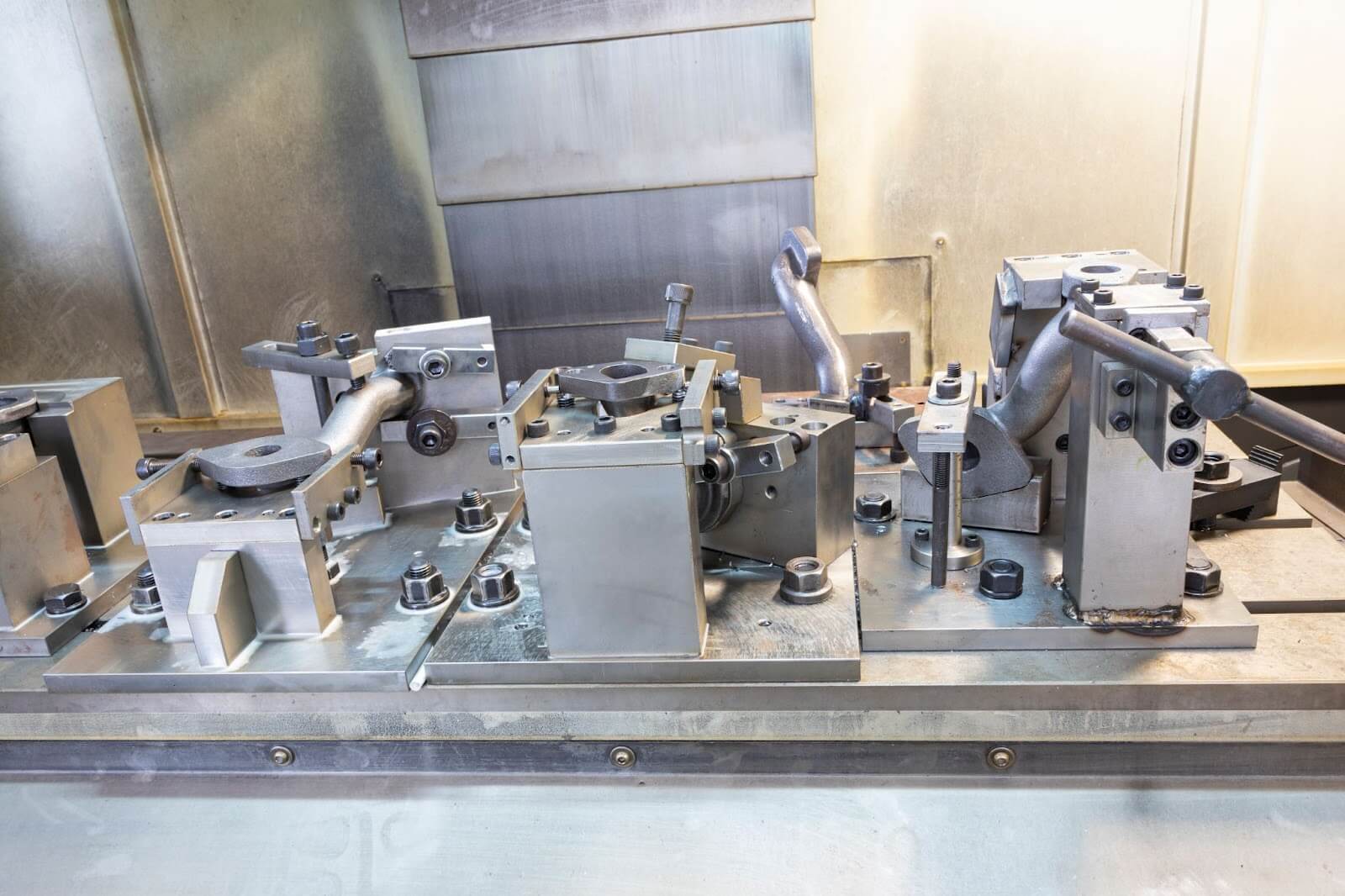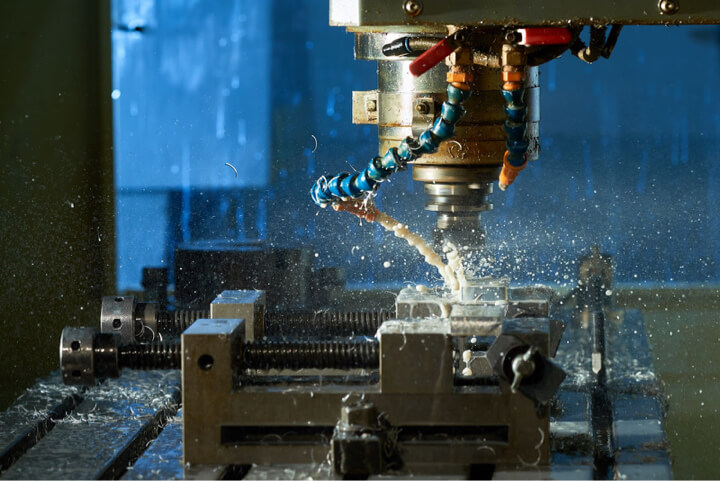Time to read: 5 min
Jigs and fixtures are frequently utilized in CNC machining to ensure precision, accuracy, and quality of CNC machined components. These are both types of engineered tooling designed to hold things in place during machining. The ability to hold things in place makes jigs and fixtures workholders for CNC machining. While both of these terms are commonly used interchangeably, there are differences between them. Let’s explore the definitions of jigs and fixtures, when to use each term, and common examples.
What is a Fixture?

A fixture is a device used to hold your workpiece in place while it’s machined. A fixture needs to be rigid, precise, and able to withstand the heat generated and coolant or oils used during machining. Rigid, accurate, and repeatable part holding is key to ensuring precision and accuracy of CNC machined parts. A fixture is also critical for positioning a part’s coordinate system prior to CNC machining. In addition, a fixture is used to reduce labor when loading and unloading a workpiece. Fixtures are especially important and useful for more complex machining processes like milling, turning, grinding, shaping, boring and planing.
Common Types of Fixtures
Fixtures for machining are broadly either part and modular fixturing systems used to hold a variety of parts (see items 1-3 below) or custom fixtures manufactured for a specific job (see item 4 below). If you can leverage modular fixturing systems for a variety of parts, you’ll often save money in the long run.
- T-Slots
These work as a groove-and-slot or pin-and-hole setup where you can slide or attach holding blocks to position your parts prior to CNC machining. T-slots aren’t as precise as custom fixtures but are less costly — there is also some associated setup time each time you go to use a modular system. To improve productivity, slots should be trued up to ensure they run parallel to the CNC machine’s axis of motion (use a dial test indicator). You can then install keys on your trued up slots for fast positioning of the edges and improved accuracy. But the most precice T-slot setup is a tooling plate with a grid and holes for dowel pins or threaded fasteners to hold the workpeice. You can purchase pre-made tooling plates or have one custom CNC machined.
- Milling Vise
The tried and true milling vise, also known as a machinist vise, is arguably the most commonly utilized fixturing device used today. In use for over 70 years, Kurt vices are popular and reliable solutions for workpiece holding. This type of vise works by clamping the part with a relocatable (swivel, translational) jaw that applies pressure to firmly hold the part in place. A milling vise offers good precision, accuracy and repeatability.
Pro-tip: Tramming a milling vise is an essential skill. Learn how to here.
- Other Modular Fixturing and Quick Change Solutions
Modular fixturing involves the use of pre-made fixturing components fastened to a grid to hold the workpiece in place for machining. Similar to the T-slot solution, this is more cost effective as far as up-front expenditures are concerned. These modular fixtures can also be quick change with a ball and bushing type locking mechanism, like the popular quick change and low tolerance Jergens Ball Lock Ⓡ mounting system.
- Custom Made Fixtures
The options for custom made fixtures are endless, ranging from custom jaws to custom vises to custom plate fixtures. Your budget is the main constraint and consideration when choosing between custom made fixtures and off-the-shelf fixtures.
It’s likely that you will need multiple fixtures to CNC machine each part, so heck out these fixture guides for more information on fixture selection and design.

What is a Jig?
While jig as a noun can mean a lively dance with leaping movements, we’re talking about machining jigs or manufacturing jigs. Moreover, a jig serves as a guide for machining tools to cut at required locations while increasing the productivity of the manufacturing process. Jigs are usually smaller than fixtures but typically require more customization, design, and machining to produce, and so are more expensive than fixtures. Jigs are more commonly used for simple processes like drilling, reaming, boring, and tapping.
Common Types of Jigs
- Drill Bushings (Drill Jigs)
Drill bushings are most commonly used to get the drill bit through the surface of the part to be machined. A drill jig may be a plate with existing holes that serves as a template to guide, locate and hold the hole positions to be drilled.
- Box Jig
A box jig is used on the face of the box that’s to be machined. The sides of the box can be turned so that multiple faces may be machined with the same jig. The box jig can also be used to drill multiple holes from multiple different angles.
- Angle Plate Jig
This jig is a supporting block used to fixture the workpiece at a set angle, typically at 90 degrees. May be built off of a solid/plain, slotted angle, and adjustable or swivel base. There are grade 1 and grade 2 angle plates — grade 1 plates provide higher accuracy often utilized in tool rooms, while grade 2 plates are used for standard machining applications.
- Sandwich Jig
A sandwich jig provides support when drilling soft or thinner parts during drilling (or general machining) to prevent bending or warping. These are complex jigs that require much consideration when designing to ensure even pressure distribution during machining.
- Channel Jig
A channel jig has a channel cross-section that’s typically u-shaped with a bushing on one side and a clamp on another side of the channel.
- Special Process Jigs
These sorts of jigs include diameter jigs to drill radial holes, welding jigs, woodworking jigs, staircase jigs and sharpening jigs.
Of course, thes are only a few of the jigs out there, but if you’d like to learn more, check out these resources for designing jigs.
Main Takeaways
Whether you’re designing consumer electronics products, aerospace components, medical devices or the next robotic innovation, you’ll likely require fixturing or jigs to machine your parts. Remember, a fixture is used to hold a workpiece during machining while a jig is used to hold and guide tooling during machining.
Sourcing Simplified – Start Your Next Project With Fictiv
At Fictiv, we are here to help source all your custom mechanical parts, including custom jigs and fixtures. Our CNC machining service can create your parts in as little as 2 days!
Fictiv is your operating system for custom manufacturing that makes part procurement faster, easier, and more efficient. In other words, Fictiv lets engineers, like you, engineer. Create an account and upload your part to see what our instant quote process, design for manufacturability feedback, and intelligent platform can do for you.










